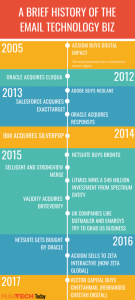Here are three areas where marketing automation leaders can find balance between consistency and the ability to transform.
Marketing automation leaders are faced with a big challenge: How to add new technologies that provide fresh ways of executing campaigns and engaging customers while maintaining the quality of older approaches.
Here are three areas where marketing automation can help with this.
Data quality and maintaining consistency
“Data quality and the ability to look across multiple systems really was foundational for marketing automation [in its history],” said Milton Hwang, principal for consultancy Mission MarTech LLC, at The MarTech Conference.
“Marketers are never done with cleaning the data, it seems,” he said. “It’s an ongoing task that we need to be agile about with new data sources, but also consistent with routines and rigor because it is absolutely table stakes to drive the personalization in our campaigns.”
Marketing automation platforms are at the heart of data-driven marketing. They’ve helped map unique data points, IDs and values, as well as classifications like state, country and industry. The evolving digital landscape is producing additional data points to be mapped. It is more important than ever that marketers maintain consistent, rigorous data management.
“If we don’t have those routines correct in the underlying system, it can impact system performance, and of course drive inaccurate leads and account routing, scoring and attribution, which is a good big portion of all this work,” said Hwang.
Data quality will become even more crucial when new AI tools are trained on it.
Integrating and aligning processes with sales
Traditionally, marketing automation helps execute campaigns that will deliver leads to sales teams. The next step in this evolution is the level of sales insights that come with the leads.
“Sales insight has now been modernized even further,” said Hwang. “Make [sales] the hero in front of their customers by giving them the data about what that customer has already engaged with digitally so that when they do make contact with them for a demo meeting, or a follow-up meeting, they can carry that insight forward and really advance the conversation.”
He added, “A lot of teams are still embracing the fact that it’s not just about the engagement tracking in marketing automation, but also using it for integrated tasks and workflows.”
An additional benefit for providing these improved sales insights is that new account executives are in a better position to close sales out of the gate, improving employee retention and shortening the learning curve.
The next generation of marketing operations
Not only does marketing automation have the power to bridge the gap with sales, but it can also align other siloed teams throughout the organization.
“Marketing automation platforms really changed the game ten years ago with native integrations,” said Hwang. “This was the original inflection point of natural language. They decrypted what was always left for the database programmers and gave that power to all of us as MAP admins in the form of attribute and field mappings that allowed us to take that time back rather than putting in requests and requirements to our IT teams to build custom integration.
The addition of GenAI chatbots to marketing automation and related platforms has enabled more team members to carry out marketing automation functions in “no-code” and “low-code” situations where they don’t have to depend on IT teams.
“We’ve got to remember that there’s more for the marketing automation platforms and the rest of the ecosystem that we can take advantage of,” Hwang said. “It’s more than just moving the data and synchronizing it in real time. [It’s about] looking beyond the native integration for additional business value.”
The post How to balance core marketing automation functions with innovation appeared first on MarTech.
MarTech(11)
Report Post







